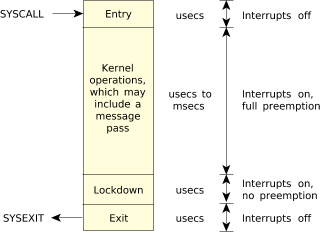The microkernel has kernel calls to support the following:
- threads
- message passing
- signals
- clocks
- timers
- interrupt handlers
- semaphores
- mutual exclusion locks (mutexes)
- condition variables (condvars)
- barriers
The entire OS is built upon these calls. The OS is fully preemptible, even while passing messages between processes; it resumes the message pass where it left off before preemption.
The minimal complexity of the microkernel helps place an upper bound on the longest nonpreemptible code path through the kernel, while the small code size makes addressing complex multiprocessor issues a tractable problem. Services were chosen for inclusion in the microkernel on the basis of having a short execution path. Operations requiring significant work (e.g., process loading) were assigned to external processes/threads, where the effort to enter the context of that thread would be insignificant compared to the work done within the thread to service the request.
Rigorous application of this rule to dividing the functionality between the kernel and external processes destroys the myth that a microkernel OS must incur higher runtime overhead than a monolithic kernel OS. Given the work done between context switches (implicit in a message pass), and the very quick context-switch times that result from the simplified kernel, the time spent performing context switches becomes “lost in the noise” of the work done to service the requests communicated by the message passing between the processes that make up the OS.
The following diagram shows the preemption details for the non-SMP kernel (x86 implementation).
 Figure 1. QNX Neutrino preemption details.
Figure 1. QNX Neutrino preemption details.Interrupts are disabled, or preemption is held off, for only very brief intervals (typically in the order of hundreds of nanoseconds).